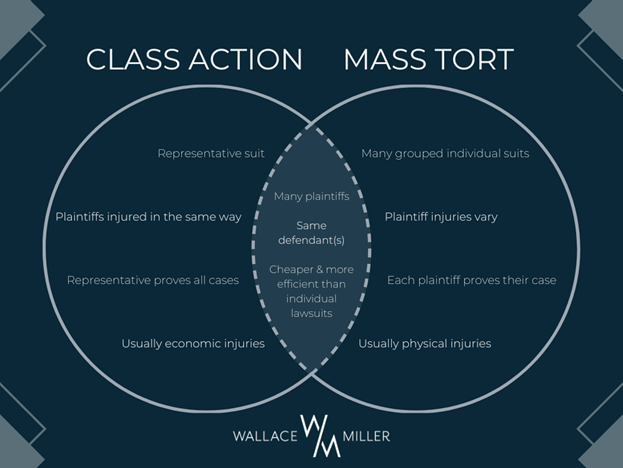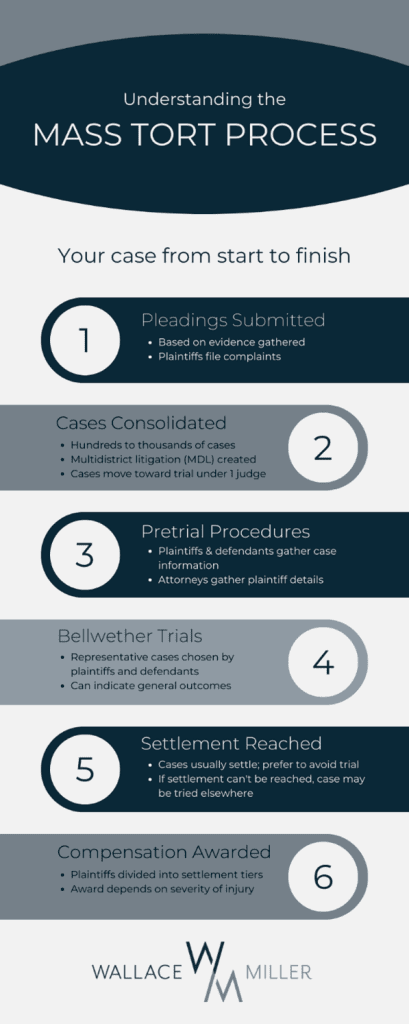Posted on Thursday, June 15th, 2023 at 6:01 pm
You’ve probably heard about, or even participated in, class action lawsuits—but you may not be familiar with their cousin, mass tort litigations. A “tort” is a wrongful act that causes injury to another person (such as negligence, fraud, and assault/battery). A “mass tort,” therefore, is a wrongful act that causes injury to many individuals, often perpetrated by a large organization in connection with a faulty product or large-scale disaster.
Like class action lawsuits, mass torts are a way for individuals to work together to hold large corporations, institutions, or other organizations accountable when they have caused harm. Frequent subjects of mass torts include defective pharmaceutical drugs, plus harmful medical equipment, and environmental hazards such as contaminated water.

Why is my case a mass tort and not a class action?
Mass torts have many of the same advantages as class actions. They can provide legal assistance to people who otherwise may not be able to afford it, and by combining hundreds or even thousands of cases, they make the judicial process more efficient and effective for everyone involved.
In a class action, one or several class representatives bring the case on behalf of the group or class. For a case to qualify as a class action, certain requirements must be met before the case can proceed. Those include but are not limited to:
- Numerosity (there are enough participants in the action to make it worthwhile),
- Commonality (the participants share common issues of law or fact),
- Typicality (the class representative is typical of the other participants), and
- Adequacy (the class representative and their attorneys can pursue the claims on behalf of the class).
In simple terms, the class representative needs to prove that they can sufficiently represent all the claims in a class action and that no factors could prevent the case from being accurately determined on a class-wide basis. This means that in class action cases, the damages are often economic—for example, all plaintiffs overpaid for a product or had their right to privacy violated by a social media company. Although the level of damages may vary, the injury is similar across all plaintiffs.
In cases where these requirements can’t be met but there are still a significant number of plaintiffs suing the same defendant over the same tort (a civil wrong), mass tort litigation is more appropriate. This is why personal injury cases are almost always mass tort cases—each individual has a unique medical history, level of injury, set of preexisting conditions, specific product usage, and so on; each plaintiff’s circumstances are unique. While the defendant caused general harm to a large group of people, the cases are not eligible to be brought in a class action lawsuit because each claimant’s circumstances are different enough that any one case would not be representative.
Class actions and mass torts serve the same function: they allow many cases against a defendant or group of defendants to be decided through consolidation. In a mass tort case, however, your litigation always remains individual. The cases are often brought together in a Multidistrict Litigation to go through the process of general discovery—obtaining the facts of the case that apply to all plaintiffs—and to determine liability. After that process is concluded, the attorneys in a mass tort case will assess the facts about the impact of the product on individual clients, as well as their individual circumstances, and the suits will continue in case-specific litigation.
What is multidistrict litigation?
Federal and state courts can get bogged down with the number of cases filed, and this is especially true when hundreds—or hundreds of thousands—of cases are being brought against the same defendant in a mass tort action. Plaintiffs and defendants can request that these cases be grouped together into a Multidistrict Litigation (MDL), which collects all similar cases into one proceeding before a single judge, to gather the shared facts of the case and resolve issues common to all plaintiffs. This increases the efficiency of the court process and helps establish consistent rulings.
The individual suits remain separate when mass torts are consolidated into an MDL. A global settlement that applies to all cases may be reached in some litigations. In others, cases may be settled individually. If cases cannot be settled, they may eventually be sent back to their home districts to be tried separately—a process that can take several years longer than a settlement.
Examples of cases consolidated via MDL include an airline crash over the Atlantic; the Deepwater Horizon oil spill in the Gulf of Mexico; and alleged harm caused by defective hip implants.

What do I need to do in a mass tort?
Your attorney is responsible for effectively using the evidence you provide to prove your case against the defendant. The plaintiffs in mass torts rarely need to appear in court. Still, it is crucial to provide your lawyers with medical information, keep us updated on any further treatment, and maintain an open line of communication.
Do you believe you or a loved one has been harmed due to negligence or fraud? Contact Wallace Miller at (312) 261-6193 or fill out our free and confidential questionnaire to evaluate your case.
Related posts
Hair Relaxer Lawsuit | L’Oréal Through History
How To Sue A Drug Company For Wrongful Death
The Bellwether Trial: What Is It & How Does It Work In Mass Tort Litigation
